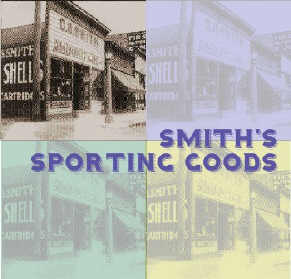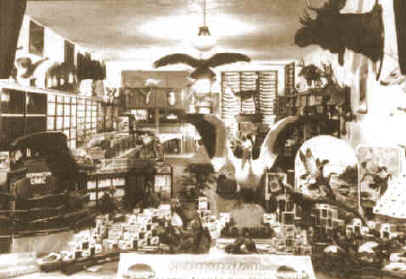|
|
Page Two |
The New Building
In 1922, the original Smith building was moved to the back of the lot and a two-story flat-roofed brick building was constructed to house the C.S. Sporting Goods and the bakery next door. The Smith store was 100 feet long and 25 feet wide. The south wall faced the alley between Park and Spring streets. The two businesses shared a center wall, and the second story above each contained a small office and three apartments, each with a bedroom, kitchen, living, and bathroom. Each morning the smell of bread baking next door filled the store. Less often the claw-foot bathtubs above overflowed, dripping water through the ceiling, and sometimes cigarettes set the garbage cans or mattresses on fire.
Where Did All the Guns and Animals Come From?
The area around Paso Robles provided great hunting, and as its popularity spread, Clark's business in guns and ammunition grew. He hand-loaded shotgun shells and was a firm proponent of very small shot, such as #10 or #11, as it didn't shove the feathers into the bird. Bob Osborne recounted that someone once pointed out that this wasn't adequate for larger birds such as duck and geese. Clark replied that what you did for larger birds was shoot them in the head. Bob said the funny part was that Clark could do it.
Through the years as farmers, ranchers and others bought new rifles and firearms, they turned in their old ones in trade. Rather than sell them, Clark hung them on the wall where the collection grew through the years to over 300. The rifles and shotguns of the ancestors of many local people came to reside in the collection which contains a 6-gauge double-barreled shotgun that killed 52 ducks when both barrels were fired, and a double-barreled stagecoach gun used between Paso Robles and Creston that had one 38-calliber barrel and one 12-gauge barrel. Also included in this collection is a shotgun with a revolving cylinder. Only 11 of these were built, as the hammer would blow off backward. One blew through the inventor's forehead, killing him.
Around 1915, Smith's sold more ammunition per capita than any other store in the state. To quote from an article from the period, "Smith's sold ammunition in quantities that would stagger the big boys."
Clark hired a young man named Eric Lungren to work in the store. Eric took a complete inventory of the guns, which was later used to identify some of them when they were stolen. In the 60's, the store was broken into, and the handgun collection was stolen by an Atascadero youth who threw them into Atascadero Lake when he found they were recognizable and that records of their serial numbers existed. In 1990-91, the lake water receded due to drought, and Ernest Porter, a resident near the lake, found sixteen of the badly corroded handguns in the lake mud. Ernest's wife, Alice, helped him clean the guns and search for the owners. Keith Tarwater, a retired Paso Robles police officer, helped the Porters track down Gary Smith, and after their serial numbers were verified, the handguns were returned. Four were put on display in the Atascadero Museum, where one has subsequently been stolen again. The rest are on display with the rifles in the Pioneer Museum.
During Bud and Lois Smith's 50th wedding anniversary celebration, one of the elder Morehouse family members recounted that when he was a boy, he was buying a deer rifle on layaway. He thinks he was paying about a dollar a month. When deer season came around, Clark let him check out the gun and buy a few shells. When he got his deer, he checked the gun back in and Clark bought back any remaining shells. Mr. Morehouse said that even though he was buying a deer rifle, he got the same deal with a shotgun during bird season.
The phone in the store had the same number as the house, 40-W, and both rang when someone called. People who forgot to pick up ammunition before a hunt could come by the house in the evening or on a holiday because ammunition in the most popular sizes was kept in the canned food closed for just such emergencies.
Stuffed animals were also added to the displays. These included some that were purchased from outside the area as well as some mounted by Mr. Spears, the taxidermist who rented the original store in the back and sometimes paid rent with stuffed animals. The mountain lion was brought in by "three men in a pickup from Pozo," and the albino coyote was reported to have come from the Hearst Ranch. Records from the store contain letters from Mr. Spears and a "Correspondence Taxidermy School" as well as orders for work from people in the area.
Mr. Spears soaked the animal/reptile/bird skins in barrels of arsenic in a small shed that had been used for storing gunpowder. From that time on, the shed was known as the "pickle" shed. Wesley (Wes) William Wimmer later used the shed as a shop to make handmade silver inlaid spurs, bridles, rawhide lariats, and other cowboy equipment. Wes' work, recognizable by his initials, "WWW," is chronicled in many books about cowboys of the West and has become collectible and quite valuable. Wes' son, Bill, continues this work today.
The old store out back was also rented by a Mr. Toews as a carpentry shop. Rent was sometimes paid in carpentry work by Mr. Toews. Some of the tables and shelving in the store---as well as family furniture, were from his hand.
The store also contained other oddities such as bear traps, early handcuffs, a wasps' nest, bird nests, an ostrich egg, a section of the first Trans-Atlantic cable, and a foot-long mammoth tooth dug up in a gravel pit in south Paso Robles.
About the authors:
Gary Smith, grandson of Clark Sherwood Smith, founder of
Smith's Sporting Goods, grew up in Paso Robles graduating
from high school in 1960 and Cal Poly in 1964. He has been
in business for himself, and he has worked the past 23 years
for Hewlett Packard in computer research and development.
Upon retirement he plans to live in Atascadero with his wife,
Janice.
Nancy Wimmer Bodendoerfer, granddaughter of Mr. Smith,
also grew up in Paso Robles graduating from high school in
1951. She has retired from teaching school and resides in
San Jose.

